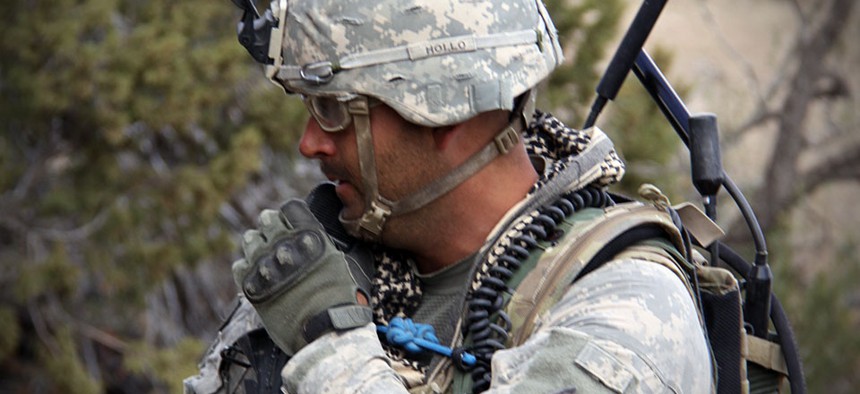Army to Manpack Tactical Radio Vendors: Go on a Diet

A Soldier from 2nd Brigade, 1st Armored Division, uses a Joint Tactical Radio System's Handheld, Manpack and Small Form Fit, known as JTRS HMS, at the Army's Network Integration Evaluation, or NIE 13.1, on Nov. 9, 2012. US Army
Other items on the Army’s to-do list: Boosting battery life and transmitting power
The Army abruptly decided last month to shrink the weight requirements and boost the transmission range of up to 60,000 tactical manpack radios it plans to buy, following sharp criticism this summer by the service’s Maneuver Center of Excellence.
The Army has already awarded low-rate production contracts to General Dynamics and Rockwell Collins for just over 5,000 manpack radios.
In a June memo, Maj. Gen. H.R. McMaster, commander of the Army Maneuver Center of Excellence, which oversees equipment requirements, blasted the radios for weighing twice as much as current Single Channel Ground and Airborne Radio System backpacks -- or, SINCGARS -- and for having a shortened range of 3 kilometers, compared to 7 for SINCGARS.
Battery life is a problem, too.
The current manpack, according to the memo, requires two batteries for six hours of operation. SINCGARS batteries, on the other hand, lasts 33 hours.
Users also raised questions about radios overheating and putting soldiers at risk of injury, National Defense magazine reported this June.
"The Maneuver Center of Excellence considers the dismounted … manpack radio unsuitable for fielding to brigade combat teams," McMaster wrote. "A radio that is heavier and provides less range while creating a higher logistics demand does not make our units more operationally capable. Additionally, any radio that places our soldiers at risk of being burned is unacceptable”
Last Thursday, the Army Contracting Command – which manages tactical radio buys – submitted a request to industry to shrink the weight and boost the transmission power of the manpack as part of an upcoming procurement.
The Army said it wants potential bidders to develop manpacks that have a threshold weight of 12 pounds and an objective weight of 8 pounds. This new weight threshold includes the radio, batteries and accessories such as handsets and antennas.
The new radio should have an objective 10-kilometer range in both SINCGARS mode and the software-defined radio channel mode. Battery life should peak at 24 hours and should be capable of recharging from AC and DC power sources.
Responses to the RFI are due this Friday, Nov. 7.
Bernie Skoch, a technology consultant and a retired Air Force brigadier general, called the Army’s new manpack requirements “state-of-the-shelf" technology.
“Design battery life since the last tranche of SINCGARS radios has improved enormously, owing mainly to improvements in battery chemistries,” he told Nextgov. “Lithium ion batteries are lighter and fit more energy into their forms, so weight and battery life should be doable too.”
He added: “The unobstructed radio line-of-sight range is not a challenge. At VHF/UHF frequencies, if line-of-sight connection between the connecting stations is truly ‘unobstructed,’ the difference between 3 kilometers and 10 kilometers is irrelevant.”
The Army plans to spend a total of $2.7 billion to acquire the manpack radios, along with vehicle and handheld radios.
“Commercial products (with far more limited capabilities) are available in the $2,000 range,” Skoch said. “With the needed waveforms, I would think a $7,000 unit price for radios alone (not including mounting kits or power amplifiers) is doable if the quantities are there."



